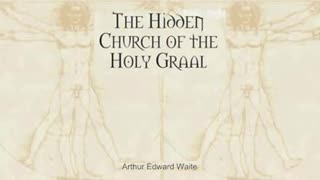Premium Only Content

The Wonderful Story of Ravalette by: Paschal Beverly Randolph (1863)
"The Wonderful Story of Ravalette" by Paschal Beverly Randolph (1825–1875) is a highly significant work in the realm of esoteric fiction and occult literature. Published in 1863, the novel blends autobiographical elements with mysticism, spiritualism, and occult themes that reflect Randolph's own experiences and teachings as an early figure in the Rosicrucian movement and a pioneer in sex magic.
Overview of the Plot:
The story follows the journey of a young man who embarks on a quest for self-knowledge, spiritual enlightenment, and esoteric understanding. Central to the narrative is the mysterious character Ravalette, who serves as a guide to hidden truths and spiritual realms. The novel incorporates themes of alchemy, transmutation of the self, and psychic phenomena, all hallmarks of Randolph’s philosophical and occult teachings.
Key Themes and Significance:
1. Autobiographical Connection: Many scholars believe that the protagonist's journey mirrors Randolph's own life path, particularly his exploration of spiritualism and mystical traditions. Randolph was known for his deep interest in the Rosicrucian Order and the mysteries of the East, which are reflected in the text.
2. Occult and Mysticism: The novel delves into mystical experiences, from astral projection to psychic visions, reflecting the spiritual doctrines that Randolph espoused. He was one of the first to introduce the concept of sexual magic as a path to higher spiritual states, though this theme is more subtly woven into the text.
3. Esoteric Symbolism: The novel is rich with symbolism that draws from Rosicrucian, Kabbalistic, and Eastern mystical traditions. The character of Ravalette can be seen as an archetype of the hidden master, a key figure in esoteric philosophy.
4. Influence on Later Occultists: Randolph’s work, including "The Wonderful Story of Ravalette," influenced later occult figures like Aleister Crowley and Madame Blavatsky. It remains an important text for those studying the history of Western esotericism and spiritualism.
About the Author:
Paschal Beverly Randolph was a notable figure in the occult and esoteric circles of the 19th century. He had several Degrees, was a part of multiple Orders, and had many Fraternal Associations, including his ties to Freemasonry and other mystical traditions. Here’s a comprehensive list of the associations and degrees that Randolph is known for:
1. Rosicrucian Orders:
Fraternitas Rosae Crucis (FRC):
Randolph is best known for founding the Fraternitas Rosae Crucis, a Rosicrucian Order that still exists today. He was highly influenced by Rosicrucian teachings, focusing on alchemy, spiritual transformation, and sexual magic. This organization is recognized as one of the oldest American Rosicrucian societies.
2. Freemasonry:
While there are conflicting accounts regarding Randolph’s involvement in Freemasonry, some sources suggest that he was at least loosely associated with Masonic circles in his time. However, there is no definitive record of Randolph being formally initiated into any specific Masonic Lodge or attaining any degrees within the traditional Masonic structure.
Despite this, many of Randolph’s teachings, especially on esotericism and spiritual growth, resonated with Freemasonic ideals, and he maintained intellectual and fraternal relationships with several Freemasons throughout his life.
3. Hermetic Brotherhood of Luxor:
Randolph is sometimes linked to the Hermetic Brotherhood of Luxor, a secret society focused on practical occultism and spiritual development. While he may not have formally been a member, his work significantly influenced this group's practices and beliefs.
4. Spiritualism:
Randolph was a prominent figure in the Spiritualist movement, especially in the 1850s and 1860s. He conducted lectures and seances, where he discussed his experiences with mediumship and the spirit world. His connections to Spiritualist societies further solidified his reputation in esoteric circles.
5. Societas Rosicruciana in America (SRIAm):
Randolph’s Rosicrucian philosophy also aligned with the objectives of the SRIAm, an offshoot of the Societas Rosicruciana in Anglia (SRIA). Although there’s limited documentation of formal membership, Randolph's ideas deeply influenced Rosicrucian groups both in the U.S. and Europe.
6. Sexual Magic and Occultism:
Randolph pioneered teachings related to sexual magic in the West. He is credited with developing the concept that sexual energy could be used as a means for achieving higher spiritual states, which later influenced occultists like Aleister Crowley and members of the Ordo Templi Orientis (O.T.O.). Although Randolph wasn’t a member of the O.T.O., his work laid the groundwork for the sexual magick tradition later adopted by the group.
7. Egyptian Mysticism and Eastern Traditions:
Randolph traveled extensively, including to Egypt, where he studied various Eastern mystical practices. He was deeply influenced by the mysticism of the East, particularly in terms of spirituality, sexuality, and personal enlightenment, which he integrated into his own teachings and writings.
-
 10:45:10
10:45:10
Deus Meum Que Jus
8 days agoThe Hidden Church of the Holy Graal 2/2 by: Edward Arthur Waite
2641 -
 LIVE
LIVE
Fresh and Fit
7 hours agoIsrael-Hezbollah Ceasefire & Reacting To Death Threats On X
5,936 watching -
 1:11:10
1:11:10
Steve-O's Wild Ride! Podcast
5 days ago $8.70 earnedDusty Slay Went From Selling Pesticides To Having A Netflix Special - Wild Ride #244
27K3 -
 1:16:02
1:16:02
CocktailsConsoles
5 hours agoBE PART OF THE GAME!!| Death Road to Canada | Cocktails & Consoles Livestream
19K1 -
 LIVE
LIVE
Phyxicx
7 hours agoWe're streaming again! - 11/26/2024
203 watching -
 LIVE
LIVE
GamingWithHemp
7 hours agoHanging with Hemp #103
1,421 watching -
 21:24
21:24
DeVory Darkins
1 day ago $10.23 earnedElon Musk and Tucker Carlson SHATTER Left Wing Media
36.5K36 -
 15:13
15:13
Stephen Gardner
4 hours ago🔥Breaking: Trump JUST DID the UNEXPECTED | Tucker Carlson WARNS America!
31.6K71 -
 1:18:01
1:18:01
Glenn Greenwald
9 hours agoWill Trump's Second Term Promote Economic Populism? Matt Stoller On Cabinet Picks To Fight Corporate Power; Should Liberals Cut Off Pro-Trump Friends & Family? | SYSTEM UPDATE #372
172K188 -
 2:26:30
2:26:30
WeAreChange
9 hours agoTrump To Subdue Deranged Opposition! ARRESTS Planned
134K56